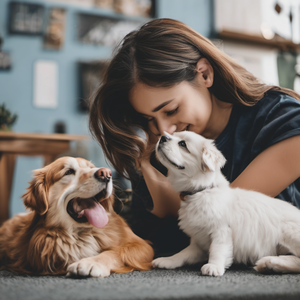Are you looking for a source of companionship and joy that will truly transform your life? Look no further than life pets. These incredible creatures have the power to bring unparalleled happiness and fulfillment to both their owners and themselves. But what exactly are life pets, and how do they enhance companionship and joy? Let’s dive into the wonderful world of life pets and discover the incredible impact they can have on our lives.
Key Takeaways:
- Life pets are an extraordinary source of companionship and joy.
- Life pets have a profound impact on the well-being of both their owners and themselves.
- Understanding the concept of life pets and their benefits is essential for those seeking companionship and joy.
- Caring for a life pet involves providing proper nutrition, grooming, and a safe environment.
- The pet adoption process is a crucial step in bringing a life pet into your life.
The Importance of Pet Ownership

Pet ownership is more than just a responsibility; it is a rewarding experience that impacts our lives in profound ways. The bond between humans and animals has been celebrated and cherished throughout history, and for good reason. Whether you choose a furry friend, a scaly companion, or a feathery buddy, life pets bring immense joy, companionship, and numerous other benefits to our lives.
“The love and loyalty of a pet is a priceless gift that enriches our lives and enhances our overall well-being.”
The significance of pet ownership extends beyond the emotional connection we share with our furry pals. It has been scientifically proven that life pets can have a positive impact on our mental and physical health. Studies have shown that interacting with animals can reduce stress, lower blood pressure and cholesterol levels, and even boost our immune system.
The Therapeutic Power of Pets

The therapeutic power of pets is well-documented, particularly in the field of animal-assisted therapy. Whether it’s a therapy dog providing comfort to patients in hospitals or a therapy horse helping individuals with disabilities improve their motor skills, pets play a vital role in enhancing our overall well-being.
Moreover, pet ownership encourages physical activity and social interaction. Taking your dog for a walk or playing with your cat not only benefits their health but also encourages us to stay active and engage with our community.
Pets as Companions
One of the greatest joys of pet ownership is the unconditional love and companionship our pets provide. They are always there to listen without judgment, offer a paw to lean on, or simply cuddle up on the couch for a movie night. The presence of a life pet can bring a sense of purpose, reduce loneliness, and provide a constant source of comfort and joy in our lives.
Whether you are seeking a faithful companion, a playful friend, or a therapeutic support system, embracing pet ownership opens up a world of love, happiness, and endless possibilities.
Caring for a Life Pet
Proper care is essential for ensuring the health and well-being of your life pet. Whether you have a furry friend or a scaly companion, following a few key guidelines will help you provide the best possible care.
Feeding
Feeding your life pet a balanced diet is crucial. Consult with a veterinarian to determine the appropriate type and amount of food for your pet’s specific needs. Remember to provide fresh water at all times.
Grooming
Grooming plays a vital role in keeping your life pet clean and comfortable. Regularly brushing your pet’s fur or scales helps prevent matting and promotes healthy skin. Additionally, grooming helps to establish a bond with your pet and allows for early identification of any skin issues or abnormalities.
Exercise and Enrichment
Just like humans, life pets require regular exercise to stay healthy and happy. Whether it’s taking your dog for a walk, providing climbing structures for your cat, or setting up a stimulating environment for your reptile or bird, engaging activities are essential for their physical and mental well-being.
Providing a Safe Environment
Creating a safe and secure environment is crucial for the safety of your life pet. Ensure that your home is free from hazards such as toxic plants, open windows, or loose electrical cords. Additionally, provide appropriate enclosures or habitats that meet the specific needs of your pet’s species.
Veterinary Care
Regular veterinary check-ups are essential for monitoring your life pet’s overall health and catching any potential issues early. Vaccinations, preventive treatments for parasites, and dental care are important aspects of maintaining your pet’s well-being.
Emotional Well-being
Life pets thrive on companionship and social interaction. Spending quality time with your pet, providing mental stimulation through play and enrichment, and ensuring a stress-free environment all contribute to their emotional well-being.
By following these guidelines and understanding the specific needs of your life pet, you can provide the care and attention necessary for a fulfilling and happy relationship.
The Benefits of Life Pets
In today’s fast-paced world, life pets have become an integral part of many households. Their presence not only brings joy and companionship but also offers a multitude of health benefits for both pet owners and the pets themselves. Research has shown that owning a life pet can have a positive impact on mental, emotional, and physical well-being.
Companionship and Emotional Support
One of the most notable benefits of having a life pet is the companionship they provide. Pets offer unwavering loyalty and unconditional love, becoming trusted confidants and emotional support systems for their owners. Whether it’s a cheery greeting at the door or a comforting presence during difficult times, pets have an innate ability to lift spirits and alleviate feelings of loneliness.
“A pet is someone who listens without judgment and loves unconditionally. They provide a sense of purpose, comfort, and companionship that cannot be replicated.”
Improved Mental Health
The positive impact of life pets on mental health cannot be overstated. Interacting with pets has been linked to lower levels of stress, anxiety, and depression. The act of petting a dog or cat releases endorphins, promoting feelings of calmness and happiness. Furthermore, owning a pet can provide a sense of routine, purpose, and responsibility, helping individuals cope with mental health conditions and promoting a more stable and fulfilling lifestyle.
Physical Well-being
Life pets can also contribute to better physical health. Owning a dog, for example, encourages regular exercise through daily walks and playtime. This increased physical activity can lead to improved cardiovascular health, lower blood pressure, and reduced risk of obesity. Additionally, studies have shown that pet owners have a lower risk of developing allergies and asthma, possibly due to the exposure to pet dander from an early age.
Comparison of Health Benefits of Different Life Pets
| Health Benefit | Dogs | Cats | Birds | Small Animals |
|---|---|---|---|---|
| Companionship and Emotional Support | ✔️ | ✔️ | ✔️ | ✔️ |
| Improved Mental Health | ✔️ | ✔️ | ✔️ | ✔️ |
| Physical Well-being | ✔️ | ❌ | ❌ | ❌ |
| Reduced Stress Levels | ✔️ | ✔️ | ✔️ | ✔️ |
As shown in the table above, different life pets offer varying degrees of health benefits. Dogs, for instance, excel in providing companionship, emotional support, and physical activities, making them ideal for individuals seeking an active and vibrant lifestyle. On the other hand, cats can offer emotional support and companionship, but may not contribute as significantly to physical well-being. Birds and small animals, while providing companionship and improved mental health, may have fewer health benefits compared to dogs and cats.
In conclusion, the benefits of having a life pet extend far beyond the joy and companionship they provide. From alleviating feelings of loneliness to boosting mental and physical health, life pets play a vital role in enhancing overall well-being. Whether it’s a dog, cat, bird, or small animal, the presence of a life pet enriches our lives in numerous ways.
The Pet Adoption Process
Are you ready to welcome a new life pet into your home? Adopting a pet is an incredibly rewarding experience, and it’s essential to understand the steps involved in the pet adoption process. From finding the right pet to completing the necessary paperwork, here’s a guide to help you navigate your way:
Finding the Right Pet
Before adopting a pet, take the time to research different breeds or specific types of animals, considering factors such as size, temperament, and energy levels. It’s essential to find a pet that fits well with your lifestyle and family dynamics. Visit local shelters, rescue organizations, or reputable breeders to meet the available pets and learn more about their individual personalities.
“Adopting a pet is not just about choosing an animal; it’s about finding the perfect companion who aligns with your lifestyle and preferences.” – Andrea Lopez, Animal Rescue Volunteer
Visiting Shelters
Visiting shelters is a crucial step in the pet adoption process. It allows you to interact with the animals, observe their behavior, and get a sense of their compatibility with you and your family. Shelters are often filled with loving animals waiting for their forever homes, and you might be surprised at the unique bonds that can form between you and a shelter pet.
Completing the Paperwork
Once you have found your perfect pet, the next step is to complete the necessary paperwork. This typically involves filling out an adoption application and providing relevant information about yourself and your living situation. Some shelters may also require a home visit or reference checks to ensure the animal’s well-being. It’s important to be honest and transparent throughout this process and provide any additional documentation required.
Considerations for Pet Adoption
- Be prepared for the responsibilities and long-term commitment of pet ownership.
- Assess your living space and ensure it is suitable for the type of pet you want to adopt.
- Consider the financial aspects of pet ownership, including food, veterinary care, grooming, and supplies.
- Ensure that all family members are on board with the decision to adopt a pet and are willing to share the responsibilities.
By following the pet adoption process, you can find a loving and loyal companion that will bring joy and happiness to your life. Remember, adopting a pet is a life-long commitment, and providing a forever home to a deserving animal is incredibly rewarding.
Responsible Pet Ownership
Owning a life pet is a tremendous responsibility that goes beyond providing food and shelter. As pet owners, it is our duty to ensure their well-being, happiness, and overall quality of life. Practicing responsible pet ownership is not only crucial for the welfare of our furry companions but also contributes to a harmonious and safe community.
The Pillars of Responsible Pet Ownership
- Proper Healthcare: Regular veterinary check-ups, vaccinations, and preventive treatments are essential for maintaining the health and longevity of our pets. Consult with a trusted veterinarian to establish a comprehensive healthcare routine tailored to your pet’s specific needs. Additionally, spaying or neutering your pet not only prevents overpopulation but also reduces the risk of certain health issues.
- Training and Socialization: Ensuring that your pet is well-trained and properly socialized is crucial for their safety and the well-being of others. Teaching basic commands, leash training, and proper behavior not only makes your pet more obedient but also fosters a strong bond between you and your furry friend. Furthermore, exposing them to various environments, people, and animals from an early age helps prevent fear and aggression.
- Providing a Safe Environment: Creating a safe and secure home for your pet is vital to their physical and emotional well-being. Pet-proofing your living space, securing fences and gates, and providing appropriate bedding, toys, and scratching posts are essential steps in ensuring their safety and comfort. Remember, pets thrive in a loving and stress-free environment.
- Adequate Exercise and Mental Stimulation: Regular exercise, playtime, and mental stimulation are crucial for maintaining your pet’s physical and mental health. Engage in activities that suit their breed, age, and energy level to keep them happy, fit, and mentally stimulated. Whether it’s brisk walks, puzzle toys, or interactive play, these activities contribute to a well-rounded and contented life for your pet.
- Nutritious Diet: Providing a balanced and nutritious diet is fundamental to your pet’s overall health and longevity. Consult with your veterinarian to determine the appropriate diet based on their specific needs, age, and breed. Ensure access to fresh water at all times and monitor their weight to prevent obesity-related health issues.
- Identification and Microchipping: Accidents and unexpected events can happen, so it is crucial to have proper identification on your pet at all times. Ensure they have a collar with up-to-date identification tags, including your contact information. Microchipping is an additional measure to increase the chances of reunification if they ever get lost.
- Respect for Others and the Environment: Responsible pet ownership also means being considerate of others and the environment. Always clean up after your pet, whether in public spaces or your own backyard. Be mindful of noise levels, especially if you live in close proximity to neighbors, and be aware of and adhere to local pet-related regulations and ordinances.
Remember, responsible pet ownership is a lifelong commitment that requires time, effort, and dedication. By following these guidelines, you can ensure a happy, healthy, and harmonious life with your beloved life pet.
Creating a Pet-Friendly Lifestyle
When welcoming a life pet into your home, it’s essential to create a pet-friendly environment that fosters their physical and emotional well-being. By making a few adjustments and implementing some thoughtful practices, you can ensure that your home is a safe and comfortable haven for your furry companion.
Designing a Pet-Friendly Home
One of the first steps to create a pet-friendly lifestyle is to design your home in a way that accommodates your pet’s needs. Consider the following:
- Choose pet-friendly flooring: Opt for durable and easy-to-clean flooring materials like hardwood, laminate, or vinyl. These options are resistant to scratches and accidents, making them ideal for life pets.
- Create designated pet areas: Set up specific spaces for your pet, such as a cozy corner with a comfortable bed or a designated play area with toys. This will provide them with a sense of security and their own special place.
- Secure hazardous items: Keep cleaning supplies, medications, and other potentially toxic substances out of your pet’s reach. Store them in locked cabinets or high shelves to prevent any accidental ingestion.
Exercise and Mental Stimulation
Regular exercise and mental stimulation are crucial for your pet’s overall well-being. Incorporate the following practices into your pet-friendly lifestyle:
- Establish a routine: Set aside dedicated time each day for exercise and playtime. This will help keep your pet active and prevent boredom.
- Engage in interactive play: Use toys, puzzles, or food-dispensing toys to stimulate your pet’s mind and keep them entertained. This can help prevent destructive behavior and promote mental enrichment.
- Consider professional walks and pet-sitting services: If you have a busy schedule, hiring a professional dog walker or pet-sitter can ensure that your pet receives the physical activity they need even when you’re unable to provide it.
Pet-Friendly Travel

When planning a trip or vacation, it’s important to consider your pet’s needs. Here are a few tips for pet-friendly travel:
- Research pet-friendly accommodations: Look for hotels, rental properties, or campsites that welcome pets. Ensure that they have the necessary amenities, such as fenced-in areas or nearby pet-friendly parks.
- Prepare a travel kit: Pack essential items like food, water, bedding, toys, and any medication your pet may need. Having these familiar items on hand will help reduce stress and discomfort during the journey.
- Use a secure pet carrier: When traveling by plane or car, ensure your pet has a secure and comfortable carrier that meets safety regulations. This will keep them safe and prevent unnecessary anxiety.
By incorporating these tips into your lifestyle, you can create a pet-friendly environment that promotes the well-being and happiness of your beloved life pet.
Ensuring Pet Health and Wellness
When it comes to life pets, their health and wellness are of utmost importance. Regular veterinary care, vaccinations, and preventive measures play a crucial role in ensuring their well-being. By prioritizing their healthcare needs, we can enhance their quality of life and strengthen the bond we share with our furry companions.
Importance of Regular Veterinary Care
Regular visits to the veterinarian are essential for maintaining your pet’s overall health. During these check-ups, the veterinarian can detect any potential health issues early on and provide appropriate treatments or interventions. These routine visits also serve as an opportunity to discuss preventive care strategies tailored to your pet’s specific needs.
Remember, just like humans, our pets also require regular dental care. Dental health is vital for their overall well-being and can prevent various oral diseases. Your veterinarian can provide guidance on proper dental care habits and recommend professional teeth cleaning when necessary.
Vaccinations for Disease Prevention
Vaccinations are crucial for preventing diseases that can seriously jeopardize your pet’s health. They help protect against common and potentially life-threatening illnesses that are prevalent in specific regions or environments.
For example, dogs should receive core vaccinations such as rabies, distemper, parvovirus, and canine hepatitis. Cats, on the other hand, require vaccines for diseases like feline panleukopenia, feline herpesvirus, and feline calicivirus. Discuss with your veterinarian to ensure your pet receives the necessary vaccinations based on their lifestyle, age, and geographic location.
Preventive Measures for Optimal Health
Aside from regular veterinary care and vaccinations, there are other preventive measures that can significantly contribute to the health and wellness of your life pets.
- Proper nutrition: Feed your pets a well-balanced diet that meets their nutritional needs. Consult with your veterinarian to determine the most suitable diet for your pet’s age, breed, and any specific health concerns.
- Exercise and mental stimulation: Engage your pets in regular physical activity and provide them with mental stimulation to keep them mentally sharp and physically fit.
- Maintaining a safe environment: Ensure your home is pet-friendly and free from potential hazards. Keep harmful substances, toxic plants, and small objects out of their reach.
- Grooming: Regular grooming, including brushing, bathing, and nail trimming, promotes good hygiene and helps prevent skin infections, matting, and other issues.
Incorporating these preventive measures into your pet’s daily routine will significantly contribute to their well-being and happiness.
“Taking proactive measures to prioritize our pet’s health ensures we can enjoy their companionship and create a nurturing environment for them to thrive.”
Sustainable Pet Ownership
As responsible pet owners, it is vital to consider the impact our choices have on the environment and future generations. Adopting a sustainable approach to pet ownership not only benefits our furry companions but also helps preserve the planet for future generations.
One way to promote sustainability is by opting for eco-friendly pet products. These products are made from sustainable materials, minimizing their carbon footprint and reducing waste in landfills. From biodegradable poop bags to organic pet food, there are numerous environmentally-friendly alternatives available.
Additionally, responsible waste management is crucial in maintaining a sustainable pet ownership practice. Properly disposing of pet waste not only prevents contamination of water sources but also reduces the release of harmful methane gases. Consider composting pet waste or using designated pet waste disposal systems to minimize environmental impact.
Supporting animal advocacy organizations is another important aspect of sustainable pet ownership. These organizations work towards protecting endangered species, conserving habitats, and promoting animal welfare. By contributing to their efforts through donations or volunteering, we play a vital role in preserving biodiversity and ensuring a sustainable future for all life pets.
Quotes
“Sustainable pet ownership is not just about our pets. It is about nurturing a healthy planet for all living beings.” – Jane Goodall
Key Points for Sustainable Pet Ownership:
- Choose eco-friendly pet products made from sustainable materials.
- Implement responsible waste management practices, such as composting or using designated pet waste disposal systems.
- Support animal advocacy organizations to protect biodiversity and promote animal welfare.
| Benefits of Sustainable Pet Ownership | Actions for Sustainable Pet Ownership |
|---|---|
| Promotes a greener planet | Use eco-friendly pet products |
| Reduces carbon footprint | Properly dispose of pet waste |
| Protects biodiversity | Support animal advocacy organizations |
Conclusion
Throughout this article, we have delved into the world of life pets and explored the myriad of benefits they bring to our lives. From the joy and companionship they provide to the positive impact they have on our mental and physical well-being, life pets truly enhance our lives in countless ways.
However, it is vital to recognize the importance of responsible pet ownership. Caring for a life pet goes beyond providing food and shelter. It entails ensuring their health and wellness through regular veterinary care, vaccinations, and preventative measures. It also involves creating a pet-friendly lifestyle that accommodates their needs, including proper training, socialization, and exercise.
By adopting a sustainable approach to pet ownership, we can contribute to the well-being of our furry companions and the environment. Choosing eco-friendly pet products, practicing responsible waste management, and supporting animal advocacy organizations are all essential steps in becoming conscientious and responsible pet owners.
In conclusion, life pets have the power to enrich our lives beyond measure. Through the bond of pet companionship, we experience love, joy, and a sense of purpose. However, it is crucial to approach pet ownership with responsibility and care, ensuring the well-being of our furry friends and creating a fulfilling companionship that lasts a lifetime.
FAQ
What are life pets?
Life pets are animals that enhance companionship and bring joy to their owners. They can include pets such as dogs, cats, birds, fish, and small mammals.
Why is pet ownership important?
Pet ownership is important as it can significantly improve one’s life. Pets provide companionship, reduce stress, and promote a sense of responsibility and purpose.
How should I care for a life pet?
Caring for a life pet involves providing proper nutrition, regular exercise, grooming, and a safe environment. It is important to consult with a veterinarian for specific care instructions.
What are the benefits of having a life pet?
Having a life pet brings numerous benefits, including companionship, reduced feelings of loneliness, increased physical activity, improved mental health, and a sense of purpose.
How does the pet adoption process work?
The pet adoption process typically involves researching and visiting animal shelters or rescue organizations, finding the right pet, completing an adoption application, and paying an adoption fee.
What does responsible pet ownership entail?
Responsible pet ownership requires providing proper healthcare, vaccinations, regular exercise, socialization, training, and meeting their basic needs such as food, water, and shelter.
How can I create a pet-friendly lifestyle?
Creating a pet-friendly lifestyle involves designing a safe home environment, establishing exercise routines, providing mental stimulation, and considering pet-friendly travel options or accommodations.
How can I ensure the health and wellness of my life pet?
Ensuring the health and wellness of a life pet involves regular veterinary check-ups, vaccinations, preventive measures against parasites, a balanced diet, regular exercise, and love and affection.
What is sustainable pet ownership?
Sustainable pet ownership refers to adopting eco-friendly practices, using environmentally-friendly pet products, responsibly managing waste, supporting animal advocacy organizations, and promoting responsible breeding and adoption practices.
What is the conclusion of this article?
In conclusion, life pets bring companionship and joy to their owners. It is important to understand the responsibilities of pet ownership and provide proper care to ensure their well-being and happiness.




